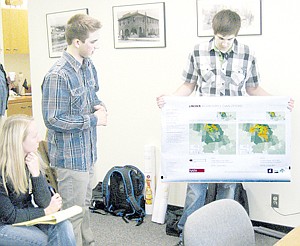Timber to jet fuel bio-mass project explained
Lincoln County commissioners on Wednesday heard from college engineering students who are participating in a bio-mass study project that could make jet fuel from timber and its byproducts.
The students, from Washington State University at Pullman, are working on a $40 million grant proposal from the USDA that would convert timber and byproducts of logging operations, such as slash, into a high-octane fuel extender for jets.
Students Blake Nelson and Steven Williams, both senior civil engineering students, spoke optimistically about the study and its potentials for impact on Lincoln County.
“Actually, the Libby area is favored as the best possible area, not only because of the timber supply but because of the availability of the water, rail and highway systems here,” Nelson said.
Nelson said Lincoln County’s transportation assets gave Libby the edge over Columbia Falls.
Nelson and Williams were presenting the findings of the study in the absence of their professor, Dr. Michael Wolcott, who became ill on the eve of the trip to Libby. Craig Rawlings, who is president and CEO of the Forest Business Network in Missoula, also accompanied the students.
“The NARA (Northwest Advance Renewable Alliance) project is also funded by Boeing and Weyerhaeuser,” Rawlings told commissioners.
With the aid of a brief PowerPoint and poster presentations, Nelson walked commissioners through the process of converting wood chips, bark and slash into isobutanol, a process similar to the ethanol process that converts corn and other products into fuel.
“We’re talking about a supplement to jet fuel,” said Kootenai River Development Council Executive Director Paul Rumelhart. “It’s meant to be like ethanol that is added to fuel for cars.”
Williams told commissioners this study is looking at jet fuel conversion because cars are becoming less dependent on fuels.
“We’re seeing hybrids in cars,” Williams said. “I don’t think we’ll ever see electric jets.”
The conversion process, Nelson said, takes days and burns cleaner than petroleum-based fuels.
The study recommends Libby as the bio-mass conversion site, specifically the Port Authority property.
The NARA project, which is still up to five years away, will report back to the USDA its findings. At that point, Rawlings said, the effort would seek investors to build the project.
“We’re looking at various closed sawmills as sites to help produce product,” Williams said. Among the closed mills Williams mentioned specifically were in Noxon and Thompson Falls.
“This project would also be looking to use existing businesses (logging operations) for contributions to this effort,” Nelson said.
“Montana would be a good location to pilot-test this program,” Nelson said of the study that seeks to benefit the four-state area of Oregon, Idaho and Washington as well as Montana.
In other Lincoln County Commission business, the board heard from Treasurer Nancy Trotter Higgins, who discussed the budget and the need to shore up the Road Fund account.
The account, which had been funded by timber sales, has seen less revenue for consecutive years.
“We used to get revenue from timber sales of 250 million board feet (per year). Now we’re seeing about 40 million board feet,” Berget said.
Higgins said the operating fund would be $2.142 million in the red at year’s end without bolstering. Commissioners directed Trotter to use the Secured Rural Schools funding to bolster the account.
Trotter also expressed concern about the current deficit in the Grizzly Bear Study, which Berget said the county was awaiting deposits from Montantore Minerals and other contributors.
Higgins agreed she would report to commissioners on the third Wednesday of every month.







